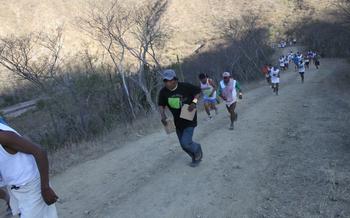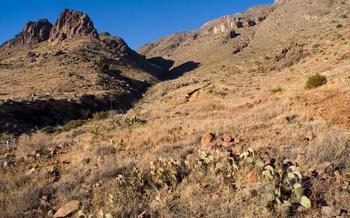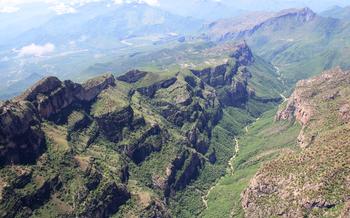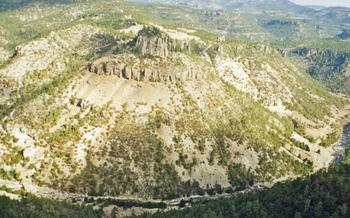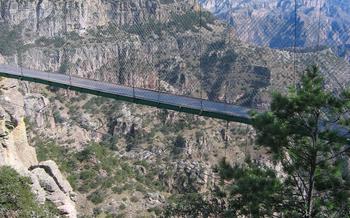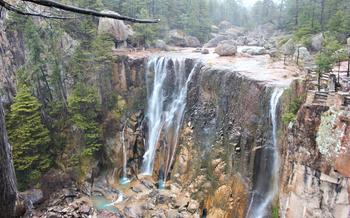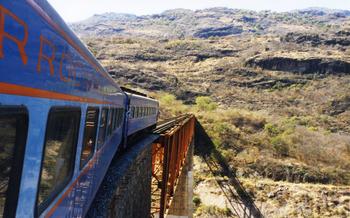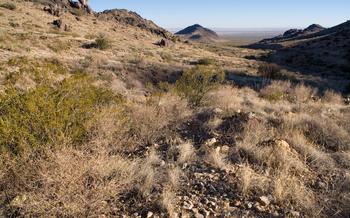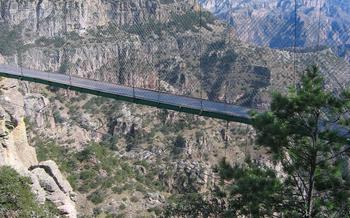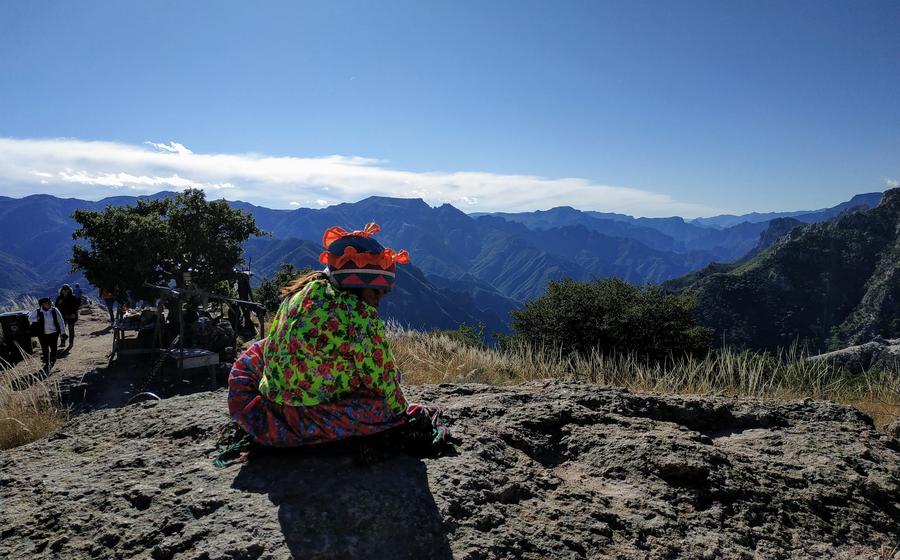
Paseo Bolivar
- The Copper Canyon: A Majestic Natural Wonder
- Discovering the Paseo Bolívar
- Getting to the Copper Canyon
- Accommodation Options in the Copper Canyon
- Gastronomy of the Copper Canyon
- Cultural Experiences in the Copper Canyon
- The Tarahumara People
- The Copper Canyon Train
- The Divisadero Viewpoint: A Window to the Copper Canyon's Grandeur
- The Urique Suspension Bridge: An Engineering Marvel in the Copper Canyon
- The Batopilas Mission: A Symbol of Faith and Resilience
- The Cusárare Waterfall
- The Cerocahui Mission
- Insider Tip: The Best Time to Visit
The Copper Canyon: A Majestic Natural Wonder
Nestled in the heart of northwestern Mexico, the Copper Canyon is an awe-inspiring natural wonder that rivals the grandeur of the Grand Canyon in the United States. This vast network of canyons, valleys, and rivers spans an area larger than the state of Rhode Island and is a testament to the power of nature's sculpting abilities.
The Copper Canyon, known locally as Barrancas del Cobre, is a system of six canyons formed by six rivers that flow from the Sierra Madre Occidental into the Pacific Ocean. It is the largest canyon system in North America and one of the deepest in the world, with depths reaching up to 1,800 meters (5,900 feet).
The region is characterized by its diverse climates, ranging from the temperate highlands to the subtropical lowlands. This climatic diversity has resulted in a rich and varied flora and fauna, with over 3,000 species of plants and 700 species of animals, including many endemic species found nowhere else on Earth.
The Copper Canyon is also home to several indigenous communities, including the Tarahumara (Rarámuri), who have inhabited the region for centuries. These communities have a rich cultural heritage, with unique traditions, languages, and customs that add to the allure of this already captivating region.
Discovering the Paseo Bolívar
The Paseo Bolívar is a beautiful promenade that winds its way through the heart of the Copper Canyon. It was built in the early 1900s and named after the famous Venezuelan liberator, Simón Bolívar. The Paseo Bolívar is a popular spot for locals and tourists alike, offering stunning views of the canyon and the surrounding mountains.
The Paseo Bolívar begins in the town of Divisadero, which is located at the rim of the canyon. From here, the promenade follows a winding path along the edge of the canyon, offering breathtaking views of the Urique Valley and the surrounding mountains. Along the way, there are several viewpoints where visitors can stop to admire the scenery and take photos.
One of the highlights of the Paseo Bolívar is the Mirador de los Monjes. This viewpoint offers panoramic views of the canyon and is a popular spot for sunset viewing. Another highlight is the Cueva del Diablo, a cave that is said to have been used by the Tarahumara Indians for religious ceremonies.
The Paseo Bolívar is a relatively easy walk, and it can be completed in about two hours. However, it is important to wear comfortable shoes, as the path can be uneven in places. The Paseo Bolívar is also a great place to spot wildlife, including birds, lizards, and even the occasional deer.
Getting to the Copper Canyon
Reaching the Copper Canyon is an adventure in itself, with various transportation options offering unique experiences and challenges.
By Train: - The Chihuahua al Pacífico train, also known as El Chepe, is a legendary journey that traverses the Copper Canyon's breathtaking landscapes. - The train ride offers panoramic views, cultural encounters, and a chance to connect with the region's history. - However, the train has limited departures and can be booked well in advance, especially during peak season.
By Car: - Driving through the Copper Canyon is an exhilarating experience, allowing for flexibility and spontaneity. - Rental cars are available in major cities like Chihuahua or Los Mochis, but ensure they are suitable for rugged terrain. - Be prepared for long driving distances, winding roads, and limited gas stations along the way.
By Bus: - Buses offer a more affordable option for budget travelers, with regular departures from major cities. - While buses provide a comprehensive network, they can be crowded and uncomfortable for long journeys. - Research bus companies and choose reputable ones for a safer and more reliable experience.
By Air: - The nearest airports to the Copper Canyon are in Chihuahua, Los Mochis, and Ciudad Obregón. - From these cities, regional airlines offer flights to smaller airports within the region, such as Creel or Guachochi. - Flying is the fastest option but can be more expensive and requires connections to reach smaller towns.
Whichever mode of transport you choose, embrace the journey as part of the adventure and soak up the stunning scenery along the way.
Accommodation Options in the Copper Canyon
The Copper Canyon offers a diverse range of accommodation options to suit every traveler's needs and budget. From rustic cabins and charming haciendas to modern hotels and comfortable lodges, there is something for everyone in this breathtaking region.
For those seeking a truly immersive experience, traditional cabañas (cabins) are a popular choice. These cozy wooden structures often feature traditional Mexican décor, private balconies with stunning views, and access to communal areas where guests can mingle and share stories.
For a touch of luxury and history, haciendas offer a unique blend of old-world charm and modern amenities. These grand estates, once owned by wealthy landowners, have been carefully restored to their former glory and offer spacious rooms, elegant dining areas, and lush gardens.
Modern hotels provide a convenient and comfortable option for travelers who prefer contemporary amenities. These hotels often feature well-equipped rooms, swimming pools, fitness centers, and restaurants serving international cuisine.
For those on a budget, hostels and guesthouses offer a more affordable alternative. These establishments typically provide basic accommodations, such as shared dormitories or private rooms, and communal kitchens where guests can prepare their own meals.
When choosing your accommodation, consider factors such as your budget, travel style, and desired amenities. Whether you prefer to stay in a rustic cabin, a luxurious hacienda, a modern hotel, or a budget-friendly hostel, you'll find plenty of options in the Copper Canyon to make your stay comfortable and memorable.
Gastronomy of the Copper Canyon
The gastronomy of the Copper Canyon is a unique blend of indigenous and Spanish influences, reflecting the region's rich cultural heritage. Traditional dishes are often centered around fresh, locally sourced ingredients, showcasing the region's diverse flora and fauna.
Must-Try Dishes:
-
Pinolillo: A refreshing drink made from ground pine nuts, cinnamon, and sugar, perfect for hot summer days.
-
Carne Asada: Grilled beef marinated in a blend of spices and herbs, served with tortillas, beans, and salsa.
-
Sopapillas con Miel: Fried pastries filled with sweet honey and sprinkled with cinnamon, a popular dessert.
-
Queso Chihuahua: A mild and creamy cheese produced in the region, used in many local dishes.
-
Caldo de Res: A hearty beef stew with vegetables, a comforting dish for chilly evenings.
Local Restaurants:
-
El Mirador: A cliffside restaurant in Divisadero with panoramic views of the canyon, serving traditional Mexican cuisine.
-
La Posada: A charming restaurant in Creel offering a wide range of regional dishes, including game meat specialties.
-
Casa de la Cultura: A cultural center in Urique that also houses a restaurant serving traditional Tarahumara cuisine.
-
El Chepe Express: The on-board restaurant of the Chihuahua al Pacífico train, offering a selection of local dishes and snacks.
Cultural Experiences in the Copper Canyon
The Copper Canyon is not only a natural paradise but also a region rich in cultural heritage. The area is home to several indigenous communities, each with its own unique traditions, beliefs, and way of life. The Tarahumara (Rarámuri) people are the most well-known indigenous group in the region, renowned for their ultra-marathon running abilities and their deep connection to the land.
Visiting the Copper Canyon offers the opportunity to interact with the local people and learn about their fascinating cultures. There are several ways to do this, such as visiting indigenous communities, attending local markets and artesanía fairs, and participating in traditional festivals and celebrations.
The local markets are a great place to find handmade crafts and souvenirs, such as woven textiles, pottery, and jewelry. These markets are also a great opportunity to interact with the local people and learn about their way of life.
Throughout the year, several festivals and celebrations take place in the Copper Canyon, offering a glimpse into the region's rich cultural heritage. These festivals often feature traditional music, dance, food, and artesanía.
Cultural immersion experiences, such as homestays and guided tours with indigenous guides, are also available for those who want to learn more about the local cultures and traditions. These experiences provide a deeper understanding of the region's history, customs, and beliefs.
By engaging with the local communities and participating in cultural activities, visitors can gain a deeper appreciation for the rich cultural heritage of the Copper Canyon.
The Tarahumara People
The Copper Canyon is home to the Tarahumara people, an indigenous community with a rich and unique culture. The Tarahumaras, also known as the Rarámuri, have inhabited the region for centuries, maintaining their ancestral traditions and beliefs. They are renowned for their extraordinary running abilities and their participation in ultra-marathon competitions, where they showcase their endurance and connection to the land. Visitors to the Copper Canyon have the opportunity to interact with the Tarahumara people, learn about their way of life, and witness their remarkable cultural heritage.
The Copper Canyon Train
The Chihuahua al Pacífico train, also known as "El Chepe", is an iconic part of the Copper Canyon experience. This legendary train journey takes you through some of the most breathtaking scenery in Mexico, offering a unique perspective of the region's diverse landscapes and ecosystems.
The train's route winds through the heart of the Copper Canyon, passing through tunnels, over bridges, and along sheer cliffs. Along the way, you'll witness stunning views of the Urique Valley, the Cuchillo Parado rock formation, and the rolling hills of the Sierra Madre Occidental.
There are three classes of service available on the train: Express, Regional, and First Class. Express trains make fewer stops and offer more comfortable seating, while Regional trains stop at more stations and are more affordable. First Class offers the most luxurious experience, with panoramic windows, plush seats, and a dining car.
To book your tickets, you can visit the official website of Ferrocarriles Mexicanos (Ferromex), the company that operates the train. It's advisable to book in advance, especially during peak season.
A journey on the Copper Canyon Train is an unforgettable experience that combines history, adventure, and natural beauty. It's a must-do for anyone visiting this incredible region.
The Divisadero Viewpoint: A Window to the Copper Canyon's Grandeur
Perched atop the majestic Copper Canyon, the Divisadero viewpoint stands as a testament to the awe-inspiring beauty of this natural wonder. From this vantage point, visitors are treated to a breathtaking panorama that will leave them breathless. The Urique Valley, with its patchwork of verdant fields and winding rivers, stretches out before you, framed by the towering Sierra Madre Occidental mountains.
The sheer scale and grandeur of the Copper Canyon are truly humbling. As you gaze out over the vast expanse, you can't help but feel a sense of wonder and insignificance. The views from the Divisadero viewpoint are postcard-perfect, with vibrant colors and dramatic contrasts that shift throughout the day.
In addition to the breathtaking scenery, the Divisadero viewpoint also offers a variety of activities and attractions. There are several hiking trails that lead down into the canyon, offering the opportunity to explore the diverse flora and fauna up close. For a more thrilling experience, you can take a zip-line ride across the canyon, soaring high above the treetops.
Whether you choose to relax and soak in the views, or embark on an adventurous exploration, the Divisadero viewpoint is an absolute must-visit for anyone traveling to the Copper Canyon. It is a place where nature's artistry is on full display, and where memories are made that will last a lifetime.
The Urique Suspension Bridge: An Engineering Marvel in the Copper Canyon
High above the Urique River, in the heart of the Copper Canyon, hangs a remarkable feat of engineering: the Urique Suspension Bridge. Completed in 1959, this bridge stands as a testament to human ingenuity and perseverance. With a length of 450 meters and a height of 140 meters, it is one of the longest and highest suspension bridges in Mexico.
The bridge's construction was a daunting task, requiring the transport of materials and equipment through rugged terrain and across the treacherous Urique River. The bridge was built using a combination of traditional and modern techniques, with local workers playing a crucial role in its completion.
Crossing the Urique Suspension Bridge is an unforgettable experience, offering breathtaking views of the surrounding landscape. The bridge's steel cables and concrete deck sway gently with the wind, creating a sense of exhilaration and adventure. From the bridge, visitors can admire the sheer cliffs, lush vegetation, and cascading waterfalls that characterize the Copper Canyon.
For those seeking an adrenaline rush, the bridge offers a unique opportunity to bungee jump or zip line. These activities provide a thrilling way to experience the canyon's grandeur and immerse oneself in its natural beauty.
When visiting the Copper Canyon, make sure to include the Urique Suspension Bridge in your itinerary. This engineering marvel is not only a testament to human ingenuity but also an unforgettable experience that will leave you in awe.
The Batopilas Mission: A Symbol of Faith and Resilience
In the heart of the Batopilas Valley, nestled amidst the towering Sierra Madre Occidental mountains, lies the Batopilas Mission, a testament to the unwavering faith and resilience of the Jesuit missionaries who ventured into this remote and rugged terrain. Founded in 1632 by Father Cristóbal de Villalta, the mission served as a beacon of Christianity, bringing solace and guidance to the indigenous communities of the region.
The Batopilas Mission stands as a testament to the enduring legacy of the Jesuit missionaries. Its imposing facade, adorned with intricate stone carvings and Baroque-style ornamentation, reflects the grandeur and devotion of its builders. The interior of the mission reveals a treasure trove of religious art, including finely crafted altars, delicate sculptures, and vivid murals depicting biblical scenes.
Beyond its religious significance, the Batopilas Mission also holds immense historical value. It played a pivotal role in the development of the region, serving as a hub for trade, education, and cultural exchange. The mission's influence extended far beyond its immediate surroundings, leaving an indelible mark on the history and culture of the Copper Canyon.
To fully appreciate the grandeur of the Batopilas Mission, visitors are encouraged to explore the surrounding landscapes. The Batopilas Valley, with its lush vegetation, cascading waterfalls, and dramatic cliffs, provides a stunning backdrop to this architectural masterpiece. Whether embarking on a leisurely stroll or embarking on a challenging hike, visitors will be captivated by the natural beauty that envelops the mission.
Tips for Visiting the Batopilas Mission:
- Guided tours are available, providing visitors with insights into the history, architecture, and cultural significance of the mission.
- Allow ample time to explore the mission's interior, admiring the intricate details and artwork that adorn its walls and altars.
- Visit the nearby Batopilas Museum to learn more about the history of the region and the role of the Jesuit missionaries.
- Combine your visit to the Batopilas Mission with a trip to the Urique Suspension Bridge, located just a short distance away.
- Make sure to bring comfortable shoes, as the terrain around the mission can be uneven and rocky.
The Cusárare Waterfall
Nestled in the heart of the Copper Canyon, the Cusárare Waterfall is a natural wonder that captivates visitors with its stunning beauty and grandeur. Located in the rugged and remote Urique region, this majestic waterfall plunges over 30 meters into a crystal-clear pool below, creating a mesmerizing spectacle that echoes through the canyon walls.
The Cusárare Waterfall is easily accessible by a well-maintained trail that leads through the lush vegetation of the canyon. As you approach the waterfall, the sound of the cascading water intensifies, building anticipation for the breathtaking sight that awaits. Once you reach the viewing platform, you will be greeted by a panorama of natural beauty that will leave you awestruck.
The waterfall's powerful force and the mist that rises from the plunge pool create a refreshing and invigorating atmosphere. The surrounding cliffs and vegetation provide a stunning backdrop, making it the perfect spot to relax, soak in the natural beauty, and capture unforgettable photographs.
For those seeking a more immersive experience, swimming in the natural pool at the base of the waterfall is a must. The water is crystal-clear and refreshing, offering a unique opportunity to cool off and appreciate the waterfall's grandeur from a different perspective.
To make the most of your visit to the Cusárare Waterfall, consider packing a picnic lunch and enjoying a leisurely meal amidst the stunning scenery. The area surrounding the waterfall is ideal for a relaxing break, allowing you to fully immerse yourself in the tranquility and beauty of the natural surroundings.
The Cerocahui Mission
The Cerocahui Mission, also known as the Misión de San Francisco Javier de Cerocahui, is a historic Jesuit mission located in the village of Cerocahui, in the heart of the Copper Canyon region. Founded in 1680 by Jesuit missionaries, the mission played a crucial role in spreading Christianity among the indigenous Tarahumara people.
The mission complex consists of a beautiful church, a courtyard, and a living quarters for the missionaries. The church features a simple yet elegant Baroque architectural style, with a whitewashed facade and a red-tiled roof. The interior of the church is adorned with intricate religious artwork, including paintings, sculptures, and a stunning altarpiece.
Visitors to the Cerocahui Mission can admire its well-preserved architecture, learn about its history and religious significance, and immerse themselves in the vibrant culture of the Tarahumara people. The mission is surrounded by breathtaking landscapes, with towering mountains, lush forests, and deep canyons providing a stunning backdrop.
To make the most of your visit to the Cerocahui Mission, consider exploring the surrounding area. Take a hike through the nearby canyons, visit the local artesanía (handicrafts) market, or interact with the friendly Tarahumara people to learn about their unique traditions and way of life.
Insider Tip: The Best Time to Visit
The Copper Canyon is a year-round destination, but the best time to visit is during the dry season, from October to May. During this time, the weather is generally mild and sunny, with little chance of rain. This makes it ideal for outdoor activities such as hiking, biking, and horseback riding.
To avoid crowds and enjoy a more authentic experience, it is best to visit the Copper Canyon during the shoulder seasons, in April-May or September-October. This is when the weather is still pleasant, but there are fewer tourists.
If you are interested in experiencing the region's cultural festivals, be sure to plan your visit accordingly. The Semana Santa (Holy Week) celebrations in March or April are particularly colorful and lively. The Festival Internacional Chihuahua (International Festival of Chihuahua) in October features a variety of cultural events, including music, dance, and theater performances.
No matter when you choose to visit the Copper Canyon, be sure to pack accordingly. The weather can be unpredictable, so it is always a good idea to bring layers of clothing. For hiking and other outdoor activities, be sure to wear comfortable shoes and bring plenty of water.
